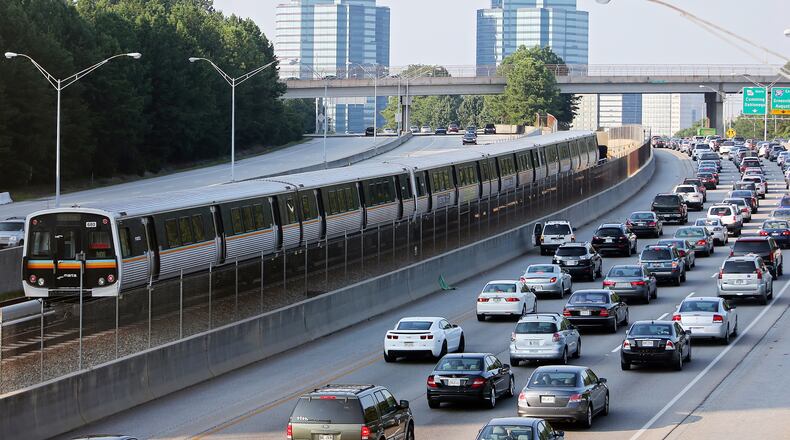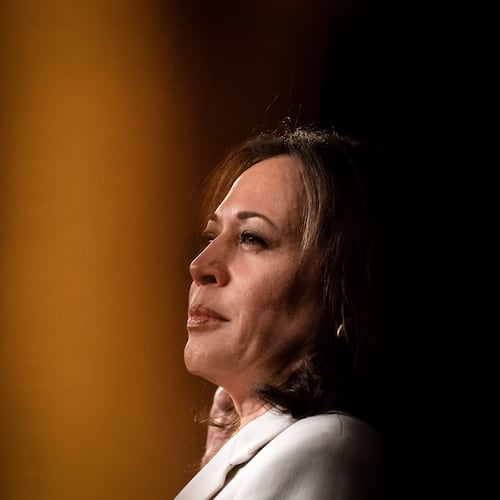For 50 years or more, even before I-285 was finished, metro Atlanta's orientation has been circular. There is Inside-the-Perimeter, Outside-the-Perimeter, and the rest of Georgia.
That landscape may be about to change. Drastically.
Over the next seven months, the people at MARTA will quietly button-hole local leaders and state lawmakers — top Republicans included — with the aim of building support for an $8 billion expansion of heavy, commuter rail that would transform the region.
The future of metro Atlanta could become startlingly linear — a single file of major economic development up and down what is now Georgia 400, built along a rail line that would link Alpharetta with downtown Atlanta and its airport beyond.
The biggest public works package in decades would have other elements as well. In DeKalb County, there would be a rail link to Emory University and the U.S. Centers for Disease Control and Prevention, plus another line shooting eastward along I-20. Within the city of Atlanta, the Beltline awaits.
But it is the proposed, five-station expansion of commuter rail into north Fulton County – four of the stops would extend beyond the Chattahoochee River – that could provoke a fundamental change in metro Atlanta’s financial geography. A rail line thrust between Cobb and Gwinnett counties, both of which have resisted mass transit, could present north Fulton with an immense competitive advantage when it comes to corporate recruiting.
Approval of state lawmakers would be required. But that blessing wouldn’t include a tax increase to pay for the new rail, according Robbie Ashe, chairman of the MARTA board. The General Assembly accomplished that this spring.
We’ll get to the mechanics in a bit. But let’s allow Ashe, a lawyer at the law firm of Bondurant Mixson and Elmore, a few paragraphs to review the changing political climate that is fueling this ambitious makeover of metro Atlanta.
First, there are the internal reforms pushed through by MARTA CEO Keith Parker. “As of a week ago, we finished another budget year in the black. It may be the first time in MARTA history we’ve had three consecutive years with a budget surplus. That’s due to Keith’s management,” said Ashe, during an interview at his downtown office.
During this year’s debate over a $1 billion-a-year transportation bill, which will go toward roads and bridges rather than rail, Republicans in the state Capitol recognized those internal improvements, and made clear that the transit agency would no longer be the butt of GOP jokes.
Once viewed as a mere vehicle for moving poor people hither and yon, MARTA has become an essential ingredient in the state’s official economic development kit, as businesses look for non-automotive paths to get car-shy, millennial employees to and from work.
“Corporations are increasingly demanding immediate proximity to transit stations. State Farm did it when they came here. Mercedes did it. Worldpay did it when it relocated. Kaiser is going to be located two blocks from here because of the Arts Center Station,” Ashe said. The trend will only continue.
MARTA has been able to generate some new revenue by leasing the real estate it owns around its current transit stations for development. But that only goes so far.
“We will never squeeze a dollar out of a dime. We will never be able to afford significant system expansion based on our existing revenue stream,” Ashe said. Which brings us back to the main question: Where can you find $8 billion in loose change?
At the tail end of this spring’s debate over House Bill 170, the aforementioned transportation funding bill, an amendment was attached by state Sen. Charlie Bethel, R-Dalton, a strong ally of Gov. Nathan Deal, to permit MARTA to ask voters for an extra half-penny tax.
The surprise measure very nearly passed, but didn’t. MARTA lacked the time to explain what the extra cash might be used for. Next year, the transit agency intends to tread a harder but more transparent route.
As passed by the General Assembly, H.B. 170 included a provision that allowed all 159 counties in Georgia to levy an additional one-cent sales tax for local transportation projects – through local referendums that can’t be held until 2016.
MARTA has approached officials in Fulton, DeKalb and Clayton counties with the idea of assigning a half-penny of those proceeds to the transit agency. Approval by DeKalb and Fulton alone would give MARTA an additional $175 million to $200 million a year.
Which, under the right circumstances, could buy $4 billion in construction bonds. Which, Ashe and other MARTA officials are betting, could be matched by an equal amount of federal dollars, resulting in a spurt of construction that would last seven to 10 years.
The only problem is that the penny sales tax granted to counties comes with a five-year sunset. That’s no good for larger, long-term bonding projects, whether involving rail or roads. Nor would would a five-year sunset convince the distributors of federal dollars that the Atlanta transit expansion had long-term, local financial support.
MARTA, Ashe said, intends to ask the General Assembly to make a slight change in H.B. 170. First, state permission would be required to allow counties to assign a portion of that tax revenue to a transit agency. The life of that tax would also have to be extended – to 42 years, the life of the current penny sales tax levied in Clayton, Fulton and DeKalb for MARTA.
Ashe’s election-year pitch: “We haven’t raised taxes, because the taxation authority already exists. It’s already state law. You just change to whom it goes, and how long it lasts.”
I asked the MARTA board chairman whether he has approached the governor with the idea. He has. “Our conversations with the governor and his staff encouraged us to seek authority from our members,” Ashe said.
One possible translation: If MARTA can demonstrate strong support for the idea from Democrats and Republicans in Fulton, DeKalb and Clayton counties, then the governor won’t slam the door on what could be a game-changing move.
About the Author
The Latest
Featured




